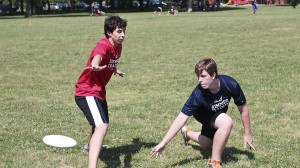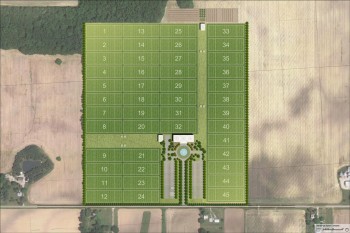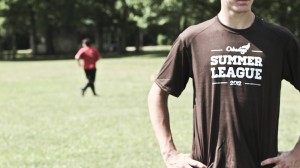Drive 20 minutes north of Columbus, Ohio and you’ll find…well, not much. You might run across one particular plot of land: 100 acres of corn and soybeans, with a dilapidated wooden barn crumbling in one corner of the fields. But when Rodger Oakes peers out over the expanse of farm and trees, he envisions field after field lined exclusively for Ultimate.
“In my vision, my dream, you drive down the road … lined with trees, get to a pond with a circular path around it and banquet hall behind that…Behind the banquet hall there is a viewing deck overlooking a showcase field,” said Rodger, the visionary behind the Oshadega fields project.

After years of setting up and directing tournament, Rodger realized that having fields that were always available would make hosting less stressful. Photo courtesy of Matt Pasternack.
The Last Straw
The road to Oshadega started at University of Missouri – Columbia, where a close friend introduced him to the sport. He fell in love with Ultimate, not for the competition, but for the community and other intangibles that make Ultimate more than just a sport.
“I truly believe Ultimate makes you a better person,” explains Rodger. “Win or lose, you can walk off the field happy because you are part of something bigger than sports.”
After graduating, Rodger started teaching high school math, but his fascination with Ultimate led him to direct a number of Columbus area tournaments such as College Nationals.
“If it were up to me, I would be running tournaments all the time,” said Rodger while discussing his love for a job that many take on simply out of necessity.
Rodger first began dreaming of a complex specifically for Ultimate tournaments after a frustrating experience with the Columbus Board of Parks and Rec, which almost left USAU without field space for the 2006 College Championships. Rodger had secured a certain soccer complex almost a year and a half in advance and was awarded the bid for the 2006 championships. In March of that year, just a few months before the series, the parks department quit returning his calls and emails. Weeks later, Rodger was informed that a local soccer organization would need the fields for a youth soccer tournament. The soccer organization had been using the fields the same weekend every year, but rather than make a formal reservation, they preferred to make a large annual donation instead. Rodger spent weeks scrambling to find other accommodations for USAU but was unsuccessful. At the last minute, the Parks Department relented and gave up the fields to Rodger as they had promised.
The tournament went on as if nothing had happened. But that was it for Rodger. Too many times he was forced to cancel tournaments because of wet field conditions. Too many times he had been stuck with a bill for field damages. And thus spawned his idea:
“We want to make this an Ultimate paradise, where they can have guaranteed field space.” A place where we can play what we want, whenever we want.
It Takes a Community
Six years later, Rodger is well on his way to creating his Ultimate Eden. He started with just a name – Oshadega – which is Iroquois for Master of the Skies. Since then, he has found a sizable plot of land, discussed zoning issues with the county, and even estimated the start up cost: a cool $1,000,000.
Some may call the dream impossible. Even Rodger admits that it will be a monumental task, but he believes it is a doable, and he isn’t alone. Oshadega has already accumulated between 400 and 450 thousand dollars of donations from individuals alone. In fact, individuals have been his only source revenue, because as he sees it, “We want to be as untied to corporations as possible.” It will be a place by the players, for the players.
The Columbus Sports Commission is also an ally in bringing what could be the first Ultimate Frisbee complex in America to their city. The commission was created in 2002, and its “primary mission is to bring in events for economic reasons, but also to raise awareness of the community and increase quality of life,” said Executive Director Linda Logan.
In the past, the CSC has worked with Roger and the greater Columbus Ultimate community to bring in the ’06, ’07, and ’09 College Championships to Columbus. Fostering one of the world’s first Ultimate complexes would signal Columbus as a leader in the sport, said Logan. What’s more, a stable site for Ultimate will hopefully attract more attention to the sport itself and pull in more members from the Columbus community.
The way Logan sees it, Roger is going about the project the right way, and she says she has faith that this monumental task can be accomplished.
“They are taking the right steps and are acting not with just their heart, but their head. If they are patient, things will come,” said Logan.
Although USA Ultimate does not have any direct ties to Oshadega, the most prominent Ultimate body in America acknowledges that the project shares many of their goals and could present opportunities to work together in the future.
“We are continuing to build our programs around the idea of partnering with local disc organizations, to help deliver quality programs to local players, especially youth,” said Will Deaver, the Managing Director of Competition and Athlete Programs for USA Ultimate. “Whether it’s Oshadega or [Columbus Ultimate Disc Association] or both in some capacity, we are excited to work with organizers who share our goals to grow the sport and provide quality local playing opportunities.”
Ultimate-specific fields aren’t a foreign concept. The Triangle Flying Disc Association of North Carolina began looking to secure land for a similar Ultimate complex back in 2001.
The Ultimate community in Ottawa, Canada bought land and developed a complex of their own in 1998. After years of development, the fields have proven that a consistent place to play can make a major impact in a community.
“While their story is pretty interesting, and full of uncertainty and lots of headaches, their complex is undoubtedly a great resource for their community and has allowed their league to really grow,” said Deaver.
Rodger’s dream remains unique in that he envisions an entire experience for visitors, not just a complex. That vision continues to grow and transform; what was once going to be fields that never closed is now a vision of a complete Ultimate experience: 40-50 groomed fields, a central indoor facility with bathrooms and refreshments, a driveway leading to parking spaces, a deck overlooking a showcase field, even fruit trees lining the complex for players to pick off of between rounds.
“The whole idea is to gear this toward players. You can set up a tent, have a good time, and you can have a great experience with your teammates and the community. That makes a sport what it is,” said Rodger.
Rodger admits it probably won’t start that big. He would be happy to have just the fields, some bathrooms, and a gravel road at first. He is adamant, however, that if the entire Ultimate community gets behind Oshadega, we can make the complex as big and as elaborate as we want.
“I don’t know how to get it off the ground without everybody…but it can be as large as we want to make it as a community,” said Rodger.
Beyond Ohio – A Place for Players Everywhere
If everything were to go as planned, Oshadega could be around for generations of Ultimate players to enjoy. But this raises an entirely new issue: how do you keep an exclusive Ultimate complex running all year round? Deaver recognizes that while fields are a critical resource for a growing Ultimate community, there needs to be a developed system in place to support the fields themselves.
“The necessary resources go beyond fields to include people willing to take on leadership roles, organize playing opportunities, coach, and pay for the time and effort it takes to organize the sport in sustainable way,” said Deaver. “Developing local playing opportunities and structures to support them is critical, and access to fields is an important part of that development.”

Rodger already runs a summer league, which he hopes to host at Oshadega one day. Picture courtesy of Matt Pasternack.
Rodger has already looked into bottom-line upkeep costs. A place like the one he envisions, he estimates, would cost between 40 and 70 thousand dollars each year to run. To meet those costs, Rodger hopes to hold tournaments as early as February (similar to Cincinnati Ultimate’s Arctic Vogue event) all the way until November. This would allow Oshadega to host between 12 and 15 tournaments each year, as well as the high school summer league Rodger already facilitates. In addition to the Ultimate events, Rodger would open up the future banquet hall to wedding parties or other Ultimate community gatherings.
Ohio is a centrally located place in terms of travel and geography in the United States, but it’s still a long hike for many teams. One solution is to simply bring the Oshadega to them:
“If we can get the money in Ohio and show people that it would work, maybe we can get one going in Georgia, or St. Louis, or Boulder,” suggested Rodger.
All costs considered, it’s foolish to put a price on one of the most progressive leaps this sport has seen. As an expert in expanding sporting communities, Logan noted that a space owned by any sporting organization allows a community to spend less time and money searching for places to play. Instead, all efforts can be focused on teaching and perfecting the sport while expanding its reaches.
Deaver also recognizes that reliable fields is essential for expanding the sport, stating that “Having a field owner with a direct connection to the sport makes that relationship easy for event organizers, leagues, and teams. A field complex that has a great relationship with the sport of ultimate opens up a lot of playing opportunities, both locally and beyond.”
Every day, Rodger is working toward making Oshadega a reality. For now, he still acts as a tournament director for a number of Ohio tournaments such as Cowabunga and Poultry Days and he runs a youth league in Columbus.
“I know I’m asking for a lot from a lot of people that have never met me,” said Rodger. “But if people can see my vision and how it aligns with where the sport is going maybe it won’t be ‘why am I giving this 20 bucks?’” Maybe instead people will ask what they can do to help.
Maybe. But the only certainty is that a project of such proportions will take patience, determination, and the support of a community. Two of the three are certainly there, and it’s up to the rest of us to decide if Oshadega is something that could change the face of Ultimate.
If you are interested in donating, visit http://oshadega.com/about/our-vision/ to see how you can help.
Correction: an earler version of this article incorrectly identified Rodger Oakes’ alma mater as Miami University in Ohio. His actual alma mater is the University of Missouri – Columbia.











Comments Policy: At Skyd, we value all legitimate contributions to the discussion of ultimate. However, please ensure your input is respectful. Hateful, slanderous, or disrespectful comments will be deleted. For grammatical, factual, and typographic errors, instead of leaving a comment, please e-mail our editors directly at editors [at] skydmagazine.com.